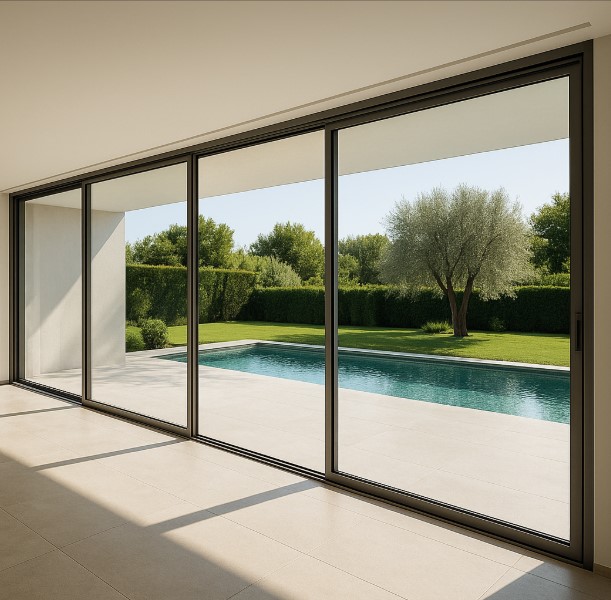uPVC vs aluminium windows – ultimate comparison

The choice between uPVC and aluminium windows isn’t just about the price per unit. What matters is durability, lead times, risk of complaints, and the total cost over time.
Aluminium windows cost 70–200% more than uPVC, but they can last over twice as long and offer 200+ RAL colours compared to uPVC’s 30 veneer options. They also allow for much larger window sizes.
In this article, you’ll get a clear, number-based comparison based on real window profiles that can actually be manufactured, not on brochure claims.
In this article you can learn about:
- What is the price difference between aluminium and uPVC windows?
- Which windows are more durable?
- What are the differences in the heat loss parameter?
- Which window will give more freedom to the architect?
- Large windows – should you choose uPVC or aluminium?
- What is the ideal solution?
Price: How much more does aluminium cost than uPVC?
Aluminium windows cost between 70% and 200% more than uPVC, depending on size, colour and system.
The main factor that will influence whether your customer decides to buy PVC or aluminium windows is the price. And this varies significantly and, depending on the profiles being compared, the difference is between 70% and 200%. Aluminium windows are almost always more expensive than PVC.
We compared the same set of PVC and aluminium windows. For PVC, the Salamander BluEvo 82 system and for aluminium, the Aluprof MB-86.
Windows. Included in the cost of the windows is the expense of servicing, the frequency of which depends on the durability of the window.


Want to compare aluminium and PVC windows in real life?
To help the investor make a decision, you can show him 2 window corner samples: aluminium and PVC. This way you can learn the differences live, with your own hands. This can speed up the decision-making process.
Check window corner samplesDurability: Which windows last longer?
Aluminium frames can last over 50 years, while uPVC typically lasts 15–25 years, depending on exposure and maintenance.
“The window fitters scratched the windows before they were even installed”. – do you know it? If you’re fed up with such problems and want peace of mind, you can choose more durable windows. We’re talking about aluminium, which is more ‘window fitter-resistant’ than PVC thanks to its hard coating. Any scratches or abrasions are much less visible and easier to hide.
The durability of windows is closely linked to the price. Why? A shorter window lifespan means more repairs and subsequent installations. The lifespan of PVC is estimated to be around 15-25 years, while aluminium windows retain their properties for up to 50 years due to their greater resistance to corrosion and sunlight.
Even a standard coating shows high resistance (also to sea salt), and there are coatings with increased resistance
PVC as a material loses its properties when exposed to weather conditions for a long time. If the PVC structure is too large, especially in a dark colour, the frame may bend and begin to cause problems. Aluminium windows are stiffer and more robust, so they will work well if the builder expects them to be extremely durable.
Thermal performance: Which is better for energy efficiency?
uPVC generally offers better insulation values (U-values as low as 0,65 W/m²K), but high-end aluminium with thermal breaks can come close.
We could spend a lot of time comparing irrelevant differences between thermal parameters. But the question is, does it make business sense to consider small differences? In fact, two factors determine the choice of a window with a specific thermal performance: building law and the type of building.
Before proposing a window system to your investor, check what minimum Uw requirement you need to meet. As a general rule, uPVC windows protect better against heat loss – they have a lower Uw parameter. The difference disappears when the window area increases because the thermal performance is mainly determined by the glass. However, at the end of the day, it is all about meeting the country’s requirements at an attractive price.
The Aluprof MB-86 profile is one of the warmer aluminium profiles, but if your investor needs an even lower Uw, you can offer him one of the passive aluminium systems, such as Aluprof MB-104 passive. However, you must remember that passive solutions involve higher costs. The question then arises about the cost-effectiveness ratio: how much will you pay extra and how much will you get in return for it?
It’s another issue if you’re building a house for yourself and you want to put windows in the showroom. Showing the window system ‘live’ can help you to negotiate with investors and get a better margin for your investment. Our customers often make their home a showroom and are then willing to pay extra for an even lower Uw than is required.

Design freedom: Which system allows more colours?
Aluminium offers over 200 RAL colours, compared to uPVC’s 30 veneer options.
What if your investor wants a non-standard window colour? uPVC windows offer approx. 30 veneer colours and aluminium windows over 200 RAL colours (thanks to powder coating). However, they are more expensive.
What if your investor wants the look of aluminium, but the price is too high? You can offer him a PVC Gealan Linear window, advises debesto specialist Stanislav Bloszko. This is a frequent choice for our customers who want a better look and at the same time an attractive price. If this sounds interesting for you, you can check by yourself and compare PVC and aluminium windows corner samples. You may also check top-ranked minimalist uPVC windows with aluminium look.
The aluminium window is considered to be more exclusive than PVC; it has a thin frame, offers greater configurability and lets more light into the room. This is due to its lighter weight and the possibility of a larger size.

Large windows – should you choose uPVC or aluminium?
Aluminium supports much larger sashes – 3 × 2,5 m compared to uPVC 2,5 x 2,5 m.
If a builder necessarily needs a very large window, then aluminium is probably the optimal choice. This doesn’t mean that a big size can’t be achieved with PVC. It depends on whether the builder wants one large glazing or whether a set of windows is acceptable.
Let’s find out the differences between the maximum dimensions of uPVC and aluminium windows. In the case of tilt and turn windows made of PVC, we can achieve a maximum of 150 x 160 cm (2,4 m2 ), while in aluminium the limit dimensions are 170 x 200 cm (3,4 m2 ), which is over 40% more. In the case of sliding doors, the possibilities for aluminium and PVC differ by a considerable margin, as the aluminium door can be almost 70 per cent larger. For example, the PVC HST Aluplast 85MM door has maximum dimensions of 510 x 250 cm (12,75 m2), while the aluminium HST Aluprof MB-77 HS Monorail has maximum dimensions of 660 x 324 cm (21,38 m2).
It should be recalled that in uPVC windows, steel is responsible for the statics of the structure, which is located inside the profile, whereas in aluminium, the frame itself provides the statics, so suppliers can make larger structures on aluminium profiles. Aluminium is more rigid and does not deform like PVC. In addition, it is lightweight and puts less strain on the hinges.

Quick check on main differences
| aluminium windows (based on Aluprof MB-86N) | uPVC windows (based on Salamander BluEvo 82) | |
| price | 8331 EUR | 3851 EUR |
| yearly price | 167 EUR (divided by 50 years) | 257 EUR (divided by 20 years) |
| thermal parameter | Uw=0,89 | Uw=0,74 |
| durablity | 50+ yearslarge glazing availablemore scratch resistance | 15-20 yearslarge glazing limitedless scratch resistance |
| colours available | 200 colours | 30 colours |
| sash+frame height | 89,5 mm | 123 mm |
Summary of key informations:
- If you are on a tight budget, and looking for a warm and economical system – choose uPVC windows.
- If you want to avoid scratching the frames during installation, want more durability and resilience, and want large glazing and a huge choice of colours – choose aluminium windows.


Is there an ideal solution?
uPVC vs aluminium windows – who’s the winner? This question is asked in the wrong way. The question should be: which type of window is best for your specific project? It depends on the purpose of your investment, what your budget is and what performance requirements you need to meet.

Check the price of uPVC windows for your project!
24 hours a day you have free access to online window price calculators. You can find out the price range of the uPVC or aluminium windows you are interested in in just a few moments. Find out the approximate price or order some products with a few clicks.
Check the windows price






